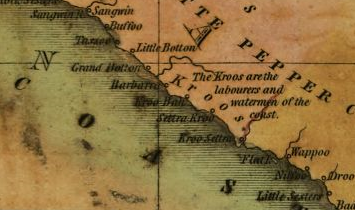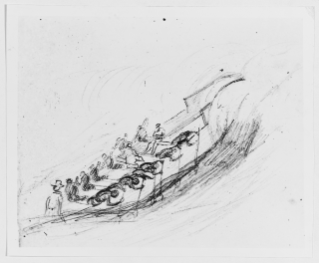As many as 100 free Black West African sailors from an ethnic group known as Kru served aboard USS Constitution in the 1850s. The sailors were hired by the U.S. Navy to serve during the ship’s two-year duty combating the illegal slave trade as part of the Africa Squadron.
Beginning in the 16th century, migrant workers from several ethnic groups in pre-Liberian West Africa, including Kru people, travelled from their homes to work both on shore along the coast and on the ships, including U.S. Navy ships, that were increasingly frequenting the region. As their reputation and role in international trade developed, the term Kru grew from describing a specific ethnic group to a unified term for West African mariners and workers from a variety of ethnic groups who were serving on European and American ships.1 These mariners became known to Americans and Europeans as “Krumen” or “Kroomen.”
White European and American ship captains and merchants hired Kru mariners for their boating skills, which included landing small boats in the open surf zones along the coast. More significantly, the captains and merchants believed Black mariners were immune to malaria and could handle the hot climate better than their White counterparts.2
When the first ships of the U.S. Navy’s Africa Squadron arrived off the coast of Africa in 1843, Commodore Matthew Calbraith Perry wrote to the Secretary of the Navy requesting authority to hire Black seamen. His request was promptly granted.
By the time USS Constitution arrived to serve in the squadron nearly 10 years later, the pattern of Kru mariners serving on U.S. Navy ships had become a fundamental element of the squadron’s complement. From 1853 to 1855, Constitution employed about 100 Kru mariners, with anywhere from about 20 to 50 in service on board at any given time. According to logbook entries, the first group to sign on were transferred from USS Bainbridge upon Constitution’s arrival at Porto Praya in the Cape Verde Islands at the end of June 1853. At that point, Bainbridge was set to return to the United States. Despite its distance from the activities along the African coast, the U.S. squadron used Porto Praya as a base of operations, reiterating the desire to minimize exposure to malaria and other illnesses, frequently referred to as simply “fevers.”


Despite the unique maritime skills that made the Kru valuable in small boat operations, nearly all of them were rated as ship’s boys – a low rating reserved for the least experienced on board. While this official rating came with a Navy salary, ship’s boys received the lowest pay among the crew. But, they were also eligible for prize money. When the schooner H.N. Gambrill was seized as a slave trader, there were 48 Kru mariners serving on board USS Constitution who were eligible for a share of the prize money.
The Kru mariners’ names are somewhat of a mystery. In the logbooks, they were given substitute Anglican names and nicknames that carried through their service on various ships, and sometimes beyond. These included commonplace English names indistinguishable from the rest of the crew (“Ben Johnson,” “Jack Smith,” “Tom Brown”). Some were given more derisive nicknames like “Pea Soup,” “Frying Pan,” “Jack Poorfellow,” and “Salt Water.” Some Kru names are repeated over the course of Constitution’s service in the squadron, but it’s difficult to tell if these names are the same person, or others given the same name. Their real names, in their own language, were not recorded in any way by their Navy employers.
Though the Kru mariners served on launches going to and from shore, they lived and worked on board the ship. On January 15, 1854, while the ship was in Porto Praya, Kru mariner John Grampus was reported as having been killed in an accident at the squadron’s storehouse ashore. He was buried there in a coffin made by the ship’s carpenters, but the detailed circumstances of his death were not recorded.


To clearly differentiate themselves from enslaved Black Africans and avoid the possibility of becoming enslaved, the Kru marked their faces with a tattoo spanning from the forehead to the bridge of the nose.3 Believed by the British to be neither enslaved nor enslavers, the Kru developed a reputation as a free people who the British tended to respect more than other Black Africans as a result.4
Kru, however, did not differentiate between enslavers and abolitionists among the Whites for whom they worked. When Constitution seized the New York schooner H.N. Gambrill on suspicion of being a slave trader, two of Constitution’s Kru mariners identified one of the men on Gambrill as a slave-trading shipowner. They had worked within the last two years on board a slave trading ship under his command, and they had seen the enslaved people loaded on board.5
The role of the Kru in British commerce and naval service continued to expand during the second half of the 19th century as Britain took broader imperial control of West Africa. Serving on merchant and British naval ships around the world, the Kru created a global diaspora as a result. But increasing Liberian regulation and restrictions of these free labor contracts eventually collapsed the Kru economy.6 By one account, the last identified contract Kru mariner served in the British Navy in World War II. Benjamin Johnson, the son of Kru chief John Johnson and Mary Johnson, shared a name with the Kru mariner Ben Johnson who served on USS Constitution nearly 100 years earlier.7
As USS Constitution’s duty in the Africa Squadron wound down in early 1855, the Kru were either discharged at Monrovia or transferred to other Navy ships at Porto Praya – where they either continued service or were returned to Monrovia. On March 26, 1855, Constitution‘s final Kru mariners were transferred to USS Marion. The next day, Constitution set sail for the voyage home.
1 Jane Martin, “Krumen ‘Down the Coast’: Liberian Migrants on the West African Coast in the 19th and Early 20th Centuries,” The International Journal of African Historical Studies 18, no. 3 (1985): 403–4, https://doi.org/10.2307/218646.
2 Jeffrey Gunn, Outsourcing African Labor: Kru Migratory Workers in Global Ports, Estates and Battlefields until the End of the 19th Century (De Gruyter Oldenbourg, 2021), 8–10, https://doi.org/10.1515/9783110680331.
3 Megan Crutcher, “‘For King and Empire’: The Changing Political, Economic, and Cultural Identities of Kru Mariners in Atlantic Africa, 1460–1945,” The Journal of African History, September 1, 2023, 6, https://doi.org/10.1017/S0021853723000567.
4 Gunn, Outsourcing African Labor, 25–26; Megan Crutcher, “‘For King and Empire’: The Changing Political, Economic, and Cultural Identities of Kru Mariners in Atlantic Africa, 1460–1945,” The Journal of African History, September 1, 2023, 8, https://doi.org/10.1017/S0021853723000567.
5 Account of Lieutenant Christopher Raymond Perry Rodgers, as transcribed by commodore’s clerk Edward Cobb into his journal, Private Journal of the U.S.Frigate Constitution’s Cruise. from December 22d 1852 to June 2, 1855. [USS Constitution Museum Collection, 235.1.]
6 Gunn, Outsourcing African Labor, 201–8.
7 Crutcher, “‘For King and Empire,’” 1.
The Author(s)
Carl Herzog
Public Historian, USS Constitution Museum
Carl Herzog is the Public Historian at the USS Constitution Museum.